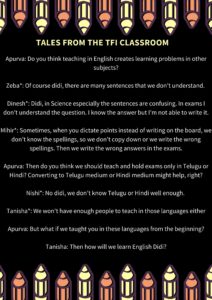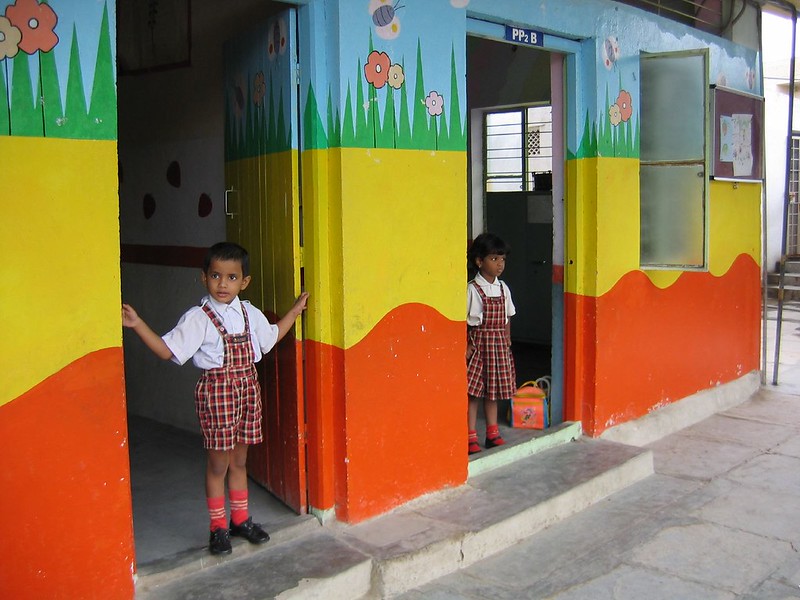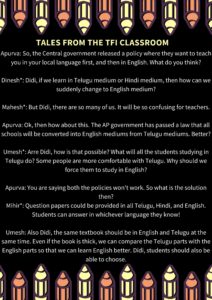
Jagan Mohan Reddy, the Chief Minister of Andhra Pradesh, made headlines in November 2019, with a proposal to convert all government schools into English-medium schools. The CM’s rationale was to provide equal access to English to all students given the rising global importance of learning the language. The proposal states that all teachers will be trained to teach in English, while supporting instruction material would also be provided as well.
But, the state of English-medium education in India is dire, with the recent Annual Status of Education Report (ASER) noting that only 50% of Grade 5 students in rural India can read a Grade 2 English text. Given this reality, which I see play out every day in my English classroom, the practicality of the policy comes under question. What is the state of English-medium learning in Andhra Pradesh and can the policy effectively remedy it?
The Extent of the Problem
‘Almost 40% of students don’t have access to education in a language that they understand’, says UNESCO’s Global Education Monitoring Report, whether the subject is Math, Science, or Social Studies. In an age where the value of bookish knowledge alone is decreasing, and hands-on learning experiences are gaining prominence, being taught in a language that one doesn’t understand negates the effort put in by the teacher to make a lesson creative and interactive. Many teachers in my school are concerned as to why Reddy’s proposal gives English so much importance, especially at the cost of other subjects.

In my experience as an English teacher for Teach for India, I’ve further witnessed how the English language impacts the way the students perform in other subjects. One example that comes to my mind is that of Ramesh*. Based on the types of questions he asked, I realised he was a smart student and expected him to top the class. While correcting his test for the first time, I was shocked to see an empty answer sheet. On paying close attention to his classroom behaviour over the next few days, I noticed he never took notes in class. Ramesh struggles with reading English. Even today, he stares out of the window because he doesn’t understand which paragraph of the text to read or how to read it.
Now, while every student has a mother tongue which is not English, there are only a few who are fortunate enough to come from families that already know the language, or have access to facilities where their children can learn and converse in it. It is the not-so-fortunate majority who have no source of learning English other than schools–and even there don’t have the adequately trained teachers to impart English education–that face the larger brunt of a poor English-medium instruction.
So, if students don’t understand the language in which their textbooks are written, this renders the material useless, and creates a high dependence on the teacher for the learning process. This dependency plays out negatively in situations of self-learning or examinations, where students have to read their own questions without help from teachers or examiners. The lack of fluency in English affects their ability to attempt a test, and so the test marks may not reflect their actual knowledge of the content. On the flip side, students who realise their inability to express their knowledge, yet still understand the requirement of a properly worded answer might resort to learning things by heart. As studies have noted, “Teaching everything in a foreign language is precisely what promotes rote-learning without understanding, and kills creativity.”[1]
A Bilingual Solution

One of the solutions that schools across the world have used to bridge the English gap is bilingual education, defined as “A language policy in education under which two languages are used as mediums of instruction.” In this model, of the two different languages, one is the ‘official’ language (English in most cases) and the other being the ‘minority’ language (or local mother tongue).
There are different variations of this method. Sometimes, both languages are equally used when teaching students. At other times, instruction is largely in the mother tongue during the early years of education. Over the years, there is a gradual shift from the mother tongue to the official language. In this system, students learn the material in a language they are more comfortable with, making the shift to the official language much smoother.
You May Also Like: Equity or Error? Assessing Andhra Pradesh’s English-ization of School Education
The 2019 National Education Policy (NEP) recommends the same model to solve the issues related to English instruction. The policy recognises the need for early grades to be in the student’s local language, suggesting that instruction be continued in local languages until grades 5-8 for students to achieve content mastery. Slowly, instruction can be transitioned into English by the time students reach grade 10. The policy also proposes bilingual Science education whereby students will be equipped by grade 10 to write and speak on Science in both their local languages and English.
The Andhra Pradesh government’s move then is at complete odds with the NEP. While the NEP proposes to set up more local language instruction mediums and provide relevant teaching materials for the same, the AP state policy does away with all of this. For these reasons, amongst many others, the bill has received flak from the state opposition, academicians, and the general public alike. But the main issue with it is that it puts school officials in a dilemma as to what to follow: the NEP’s goals, or Reddy’s.

On the other hand, students are well aware of what works for them and what doesn’t. They are also clear about what needs to be improved in the education system. Sadly, they are unaware of what policies are being made for their benefit, and perhaps worse, their opinions are not heard when these discussions happen.
Moving Forward
Given all the research and experiences with students, it appears that as well-intentioned as Reddy’s policy is, it doesn’t address the present concerns of students and teachers. What is the use of luring students and parents with ‘angrezi medium’ dreams when the students would pass out with questionable knowledge and skillsets? Bilingual education is the way to move forward and the National Education Policy addresses exactly this. It correctly recognises that language has a large impact on the cognitive abilities and knowledge acquisition of the students and hence has chosen to leverage instruction in local languages to improve the quality of education that the children gain. Until such models are seriously considered by Reddy and his government, the future of Angrezi Medium in Andhra looks bleaker than anything.
[1] Rao, A. (2013). The English-Only Myth: Multilingual Education in India, Language Problems & Language Planning, 37, 10.1075/lplp.37.3.04rao.
*Names change







[…] You May Also Like: The Future of Angrezi Medium in Andhra Pradesh […]
Adding to the article, there is a dire need of effecient trained teachers too. It’s been ages that teacher recruitment happened and existing teachers were from mother tongue background. At what expense, Teacher’s get trained and how do they teach. We need more of ngo’s like Teach for India in Andhra Pradesh to bring English into curriculum and teaching methods.
Thought provoking article, well thought out, the inferences about the ground reality of the children are very much for all of us to ponder over. The author may also attempt to seek solutions, primarily in other states of India. This will broaden the horizon of the research. The end result is a feasible working alternative to the Government to implement the changes and see improvement in the teaching of the Children who are the moulders of the nation.
I like this , becouse students speck english good ,& they improve to speck english.